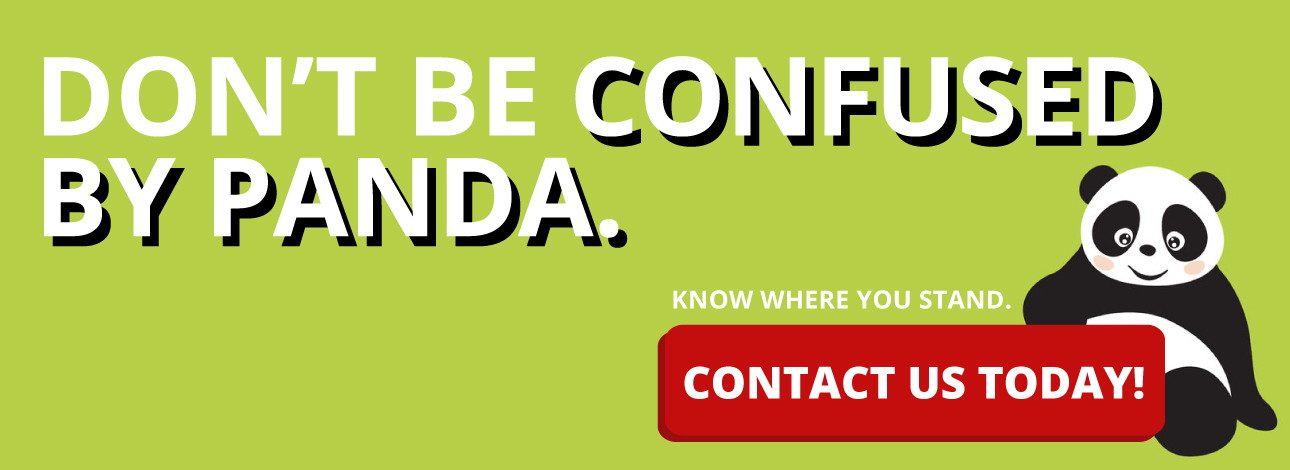Everyone wants their site to rank on Google. Favorable spots on search engine results pages (SERPs) lead to clicks to your website, and, hopefully, to conversions. That’s why it’s so important to keep tabs on the latest changes, but tracking these can be difficult. That’s where we come in.
We’re here to let you know that Google has made a significant update to Panda, their search results ranking algorithm that targets low-quality content on websites. In this post, we’ll get into:
- Google’s search ranking algorithm
- Understanding the Panda update
- What you need to know about the new algorithm update
- How it will affect website owners like you
- What you can do right now to help your site
The Google Core Search Algorithm
If you’ve ever felt confused or overwhelmed by Google’s constant algorithmic changes, or if you’re wondering what Google’s algorithm actually is, you’re not alone.
When you search for something on Google, the results page populates with links to various web pages. The idea is to show the most relevant and useful information based on what you’re searching for, and the algorithm is what decides which pages should rank over others.
There are many factors that influence a page’s rank on Google’s search results pages (such as keywords, page load speed, user experience, etc.), and working to improve a website’s ranking on a search engine is known as SEO (Search Engine Optimization). Even if you don’t understand exactly how they got there, there are concrete things you, as a website owner, can do to improve your search engine rankings.
What is Panda?
Panda was released in 2011 as an algorithm update that targeted website pages with poor-quality content. When it was released, this update was separate from the main Google algorithm described above. This might seem confusing, but the distinction is important for a couple of reasons.
First, the peripheral updates like Panda and Penguin (yes, they like naming their updates after animals…) are not updated as frequently as the main algorithm. If a website has some quality issues, it’s caught by Panda and the site’s rankings suffer as a result.
If that site immediately fixed or updated the content in question, they would have to wait for the next Panda update for Google to recognize those changes. Updates are sometimes several months apart, so sites would continue to be punished for things they had already addressed.
The second reason why it’s important to note that Panda was created as a separate update is that, as of this month, Panda is now a part of the main Google algorithm. So let’s look a little closer at this update and what it does (and does not) entail.
What Is This New Update?
This new update (in a nutshell) moved Panda into the main Google algorithm. This algorithm is constantly maintained, updated, and improved upon, so we won’t have to wait months between updates anymore. It still targets the same thing – content that is not helpful to the user.
As the most popular search engine in the world, Google wants to provide a positive experience for its users. To do that, they need to provide the very best and most relevant search results for each person. The inclusion of Panda in the core algorithm is indicative of how seriously they take this, specifically with content.
If you’re wondering whether Panda could be affecting your rankings, take a look at the following factors. We’ll also let you know what you can do to fix any problems in the next sections.
Panda Targets:
- Content with keywords unrelated to the subject matter
- Content with keywords and subject matter that don’t help users
- Content that is too similar (multiple posts on the same exact subject)
- Spammy posts (“Buy X”)
- Spammy comments or comments where users are arguing with each other for no reason (moderation on your part is key)
- Republished RSS feeds
- Pages with too many ads and/or affiliate links in relation to content
Panda Does NOT Target:
- An entire website when only one page contains bad content (that one page’s ranking will be affected)
- Duplicate content (although this should be cleaned up, regardless, to maintain positive UX and avoid penalization)
- 404 pages
- Content under a certain word amount (some of the shortest information blurbs can end up in Google Knowledge Graph boxes)
- Content in the form of images and videos instead of text
Indications of a Panda Penalty
Now that you understand more of what the Panda algorithm entails, how do you make sure that your site isn’t being affected? Or if it is, how do you resolve the issue?
In order to identify any potential web pages being penalized in SERPs, you have to consult the referral traffic section of Google Analytics. You’ll want to look solely at organic, since that will show you only those visitors arriving at a particular page through a Google search. If you come across pages where there is little or no organic referral traffic, these could be an indication of a Panda penalty.
There are a couple of other factors that could signal a Panda penalty, including a drastic drop in traffic or an inability to rank despite a large number of backlinks. If you have a piece of content or web page with quality backlinks to reputable sources and it is still struggling to rank, the overall content quality is likely to blame. Despite the fact that links remain one of the most important ranking factors, they cannot compensate entirely for poor-quality content.
This outlook might seem a little bleak, but it’s important to know that Panda is the most commonly applied Google penalty out there, affecting nearly every website at some point. So while it might hurt to see your pages drop in search results, you’re certainly not alone. And even better, the road to recovery isn’t that hard!
The Road to Recovery
Since it touches on such a wide range of content and user experience related components, it’s not always easy to diagnose what could be the effects of Panda. The good news is that most websites will be able to bounce back from a Panda penalty even faster than before now that it’s a part of the core algorithm. Once you’ve determined which pages aren’t receiving organic referral traffic, you can look at the title tags associated with each page to identify duplicate titles, indicating that the content itself may be duplicated and should be improved or removed from Google’s index. It’s ok to have a few of the same title tags across different pages; not every single page on a website will have entirely new text or imagery.
However, if you find that several pages have the same title tag, there are a couple of ways to proceed. If there isn’t a duplicate content issue, you can simply update the title tag. But if the content is too repetitive, you should NOINDEX these pages so that Google knows not to crawl them. Even better, find ways to rework the existing content or add new information to make all of your pages valuable and give search engines more quality content to consider ranking.
Some SEOs argue that in these situations you should simply delete the pages from your website, but it’s important to try and avoid doing this. Removing pages could make your site even harder to find on Google or you could accidentally eliminate information that your visitors or other search engines found valuable. It’s easy to forget that search engines other than Google have their own algorithms and ranking policies in place, so what might be deemed valuable on one might not be on another. That’s why you have to pay close attention to your referral traffic so you know where your audience is coming from.
It can take time to analyze your entire website and identify areas where content is thin or poor quality, but once you modify the content or NOINDEX pages as needed, you should start to see your rankings improve. You should always look for ways to improve the user experience on your website, educating visitors and building trust so that they hopefully decide to purchase from you. Whether it’s a new strategic approach to your blog, more thoughtful product pages, or user-submitted content, there are plenty of ways to revitalize your site and get back in Google’s (and your visitors’) good graces.
If you think your website is suffering from a Google penalty or you have any questions about how the ranking process works, contact us today for a content analysis!



